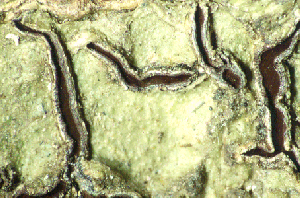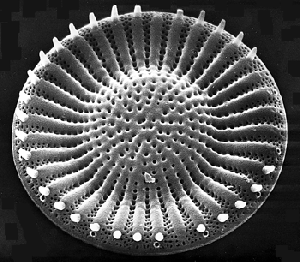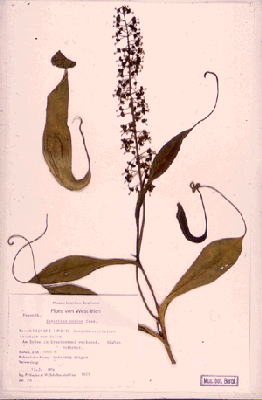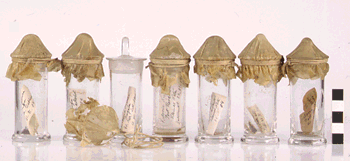Our gardens and greenhouses contain many different kinds of plants. However, many more can be found in the museum building. They are not kept alive, but conserved and usually dried. Our collection of dried plants is called a herbarium. In a more plastic way it is also called a "Hortus Siccus" or "dried garden". It offers a great wealth of plants of all kinds from all over the world, a fascinating place even though the colors and the beauty of the living plants are no longer present. Maintained for research, the herbarium helps to find out how plant species can be recognized, and where they grow. It is accessible only to researchers. Therefore the Little Tour shows you a virtual Hortus Siccus, with a selection of objects from the herbarium.
 This picture shows a highly magnified lichen. Its scientific name is Phaeographina montagnei It does not produce flowers, but reproduces itself by spores. These are produced in the red, elongate parts. They are characteristic of the species.
This picture shows a highly magnified lichen. Its scientific name is Phaeographina montagnei It does not produce flowers, but reproduces itself by spores. These are produced in the red, elongate parts. They are characteristic of the species.
 This is a still more highly magnified object. It measures 0.04 mm across and is the cover in which a species of alga lives. The scientific name is Cyclostephanus muelleri and it belongs to the group of the Diatoms. It was found in lake Malawi in Africa. The picture is not in color, because it was made with a scanning-electronmicroscope.
This is a still more highly magnified object. It measures 0.04 mm across and is the cover in which a species of alga lives. The scientific name is Cyclostephanus muelleri and it belongs to the group of the Diatoms. It was found in lake Malawi in Africa. The picture is not in color, because it was made with a scanning-electronmicroscope.
 Normal-sized plants are dried for conservation. Then they become brittle and therefore they are also pressed, and pasted on a sheet of paper. The picture shows a Nepenthes maxima from the mountains of New Guinea.
Normal-sized plants are dried for conservation. Then they become brittle and therefore they are also pressed, and pasted on a sheet of paper. The picture shows a Nepenthes maxima from the mountains of New Guinea.
Certain fruits, flowers and waterplants are too much damaged by pressing and drying, and therefore conserved on spirit in bottles. The "Hortus Siccus" is not completely dry! The bottles on the picture were closed about 100 years ago with pigskin. They contain algae from East Africa, collected when there was a German colony.

Return to the Little Tour...
